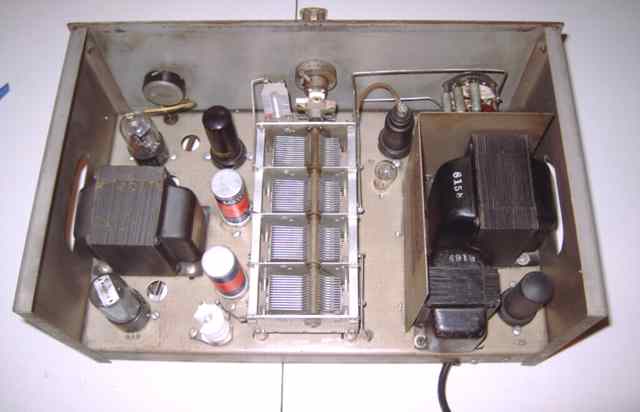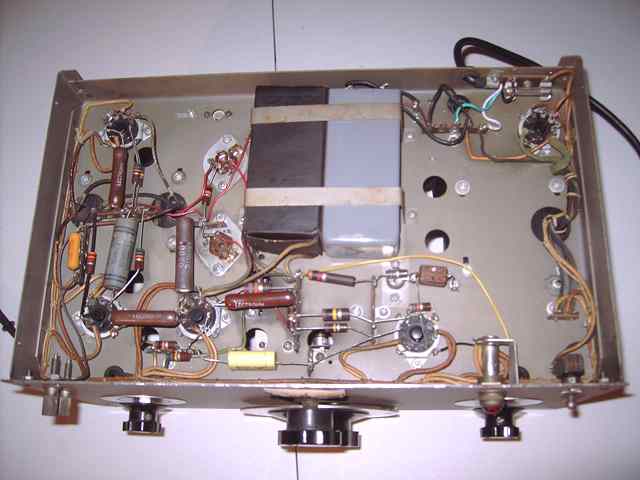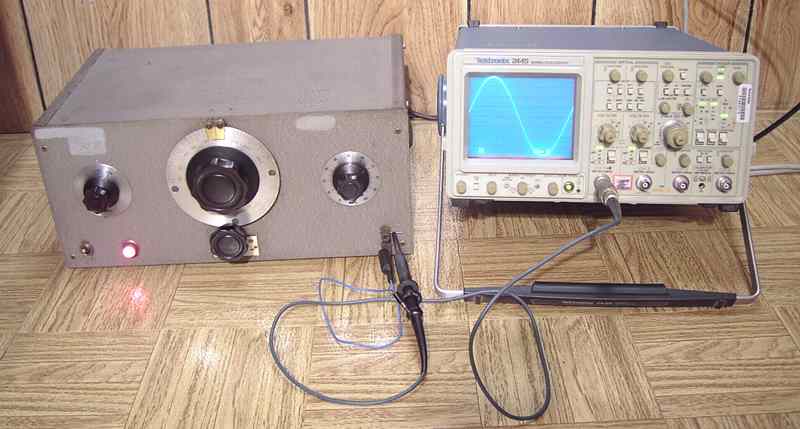
After repairing several other Hewlett Packard oscillators such as the HP-200C , the HP-200CD , and the HP-200AB , I chanced upon this HP-200A which is the company's original product. (Link is to the HP history site detailing the 200A) .
Like the other HP oscillators, the HP200A is a Wien bridge resistance-tuned audio oscillator using the light-bulb stabilized negative feedback circuit designed by William Hewlett while doing graduate work at Stanford. (Patent #2268872. Application filed in 1939 and granted in 1942). Early serial numbers of the HP-200A were built and sold out of fellow Stanford grad David Packard's garage marking the founding of Hewlett-Packard.

This HP-200A included a photocopy of the manual with schematics for the HP-200A as well as the "B" and "C" versions. Manuals can be downloaded from the HP Archive site.
The main differences between model 200A and 200B is frequency coverage. The same schematic applies to both models. Model 200A covers 35 to 35,000 Hz. Model 200B substitutes several frequency-determining resistors to achieve the frequency range of 20 to 20,000 Hz. The values for those resistors for either the 200A or the 200B are listed on the schematic. All other circuit elements are the same for the two models.
Output for the 200A (and 200B) is specified as 1 watt into 500 ohms. The initial price of the 200A in 1939 was $54.40.
Comparison to the HP-200C
As noted above, I had earlier repaired a model HP-200C . The HP-200C is similar to model 200A but its audio amp uses two stages of resistance coupling with a capacitor output instead of the transformer output found in Models 200A and 200B. Therefore the 200C has a greater top end of 200 KHz but has an output of only 100 milliwatts at 1000 ohms.
Music for the Mouse - the Disney Connection and "eight track" stereo sound  Disney studios wanted an audio oscillator that could go down to 20 Hz for recording and testing for their Fantasound sound system for the animated movie Fantasia which pioneered multi-channel theater sound. Hewlett and Packard modified their oscillator to handle the lower frequency, hence the model HP-200B. Disney ordered eight of the 200B oscillators as part of the requirements for recording Fantasia.
Disney studios wanted an audio oscillator that could go down to 20 Hz for recording and testing for their Fantasound sound system for the animated movie Fantasia which pioneered multi-channel theater sound. Hewlett and Packard modified their oscillator to handle the lower frequency, hence the model HP-200B. Disney ordered eight of the 200B oscillators as part of the requirements for recording Fantasia.
Fantasound was Disney's name for a sound system contracted with RCA that recorded eight different music tracks resulting in the first true stereo "surround sound" with full separation in motion pictures. Fantasound was not only a unique recording system but required an expensive eight discrete channel sound system for theater playback. The Fantasia premiere took place in New York in 1940 to enthusiastic reviews especially for the sound. Fantasia music conductor Leopold Stokowski received a special Oscar for "widening the scope of the motion picture as entertainment and as an art form".

Repairs
This HP-200A, Serial Number A13468, was very dirty but not abused. Waterless hand cleaner was used for a thorough cleaning of the set. Contact cleaner was applied to the range switch and volume control. The power switch showed no continuity. That problem is typical in long dormant equipment. With the HP-200A on its back and the switch facing upwards, contact cleaner was applied through the bat handle to solve the problem. As usual, a check was made to assure there was no leakage from the AC line to chassis. This was followed by checking for a proper level of high resistance in the B+ line. A slow power-up was used to reform the electrolytics while observing current draw and B+ voltage.
A check with the oscilloscope showed the unit working but with a distorted waveform. Per suggestions in the manual, the problem was traced to the 0.5 MFD coupling cap in the oscillator circuit at the input grid of the 6F6 (replacement is yellow-colored cap in the chassis view shown above). I also suspected the 0.1 coupling cap to the grid of the 6V6 output tube but was surprised to find it in good order. Just replacing the one oscillator coupling cap brought the device to proper operating as shown on the scope display. The power cord was replaced with a three wire grounded version to complete the repairs.

The HP-200A is very solidly constructed with an audio transformer that is larger than its power transformer. The manual recommends keeping the output level control to a bit under maximum to limit distortion to its specification of less than half of one percent. This was confirmed by scope observation. By maxing the output level, a bit of distortion on the upper end of the sine wave was visible. Backing the level just a bit produced the clean waveform as shown.
More circuit information
For lots more information on the HP-200 resistance-tuned light-bulb-stabilized feedback circuit and a description from the earliest HP catalog, see the notes on the HP-200C page.
A Lafayette HA-350 ham-bands receiver was the previous item on the bench.